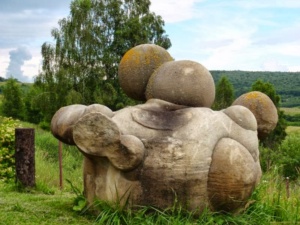 Mother Nature goes to work creating odd and mysterious rocks. Brilliant colors, endless shapes, trick crooks and crannies. But how!
Mother Nature goes to work creating odd and mysterious rocks. Brilliant colors, endless shapes, trick crooks and crannies. But how!
They are called trovants. Stones that grow when it rains, move on their own volition, and seem to reproduce as well. What! Somebody is pulling my leg here. Just couldn’t leave this one alone and did some digging to find out exactly what was going on. Just when you think you have heard it all. At first glance, I though these were mushrooms gone wild. No, they are actually stones gone wild.
Trovants are readily found in the small village of Costesti of Romania. Here resides The Romanian Trovants Museum Natural Reserve. These rocks came into existence due to the many earthquakes occurring over six million years ago with the large sand reservoirs created.
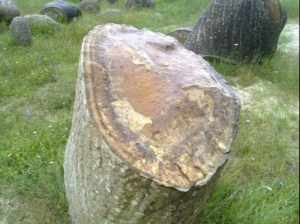 The stones are spherical or elliptical in shape with a hard stone core and outer layers of sandstone. They are smooth without sharp edges. Their shapes are altered inconsistently as they grow with random secretions of cement. A process called cementation takes place to causes the stones to grow and multiple. Trovants are made in areas with porous sand accumulations. The sand is fused by waters rich in calcium carbonate thus creating the sandstone. Layers are added causing a tree-ring effect. By cutting the stone open the age can be determined by how many rings are present. Trovants, also, appear to have some type of root extensions, although scientists are not yet certain for the explanation of these unique attributes.
The stones are spherical or elliptical in shape with a hard stone core and outer layers of sandstone. They are smooth without sharp edges. Their shapes are altered inconsistently as they grow with random secretions of cement. A process called cementation takes place to causes the stones to grow and multiple. Trovants are made in areas with porous sand accumulations. The sand is fused by waters rich in calcium carbonate thus creating the sandstone. Layers are added causing a tree-ring effect. By cutting the stone open the age can be determined by how many rings are present. Trovants, also, appear to have some type of root extensions, although scientists are not yet certain for the explanation of these unique attributes.
Now we come to the Sailing Stones of Death Valley. Scientists have been left baffled as to why stones on their own accord can move across the dry lake bed leaving a discrete trail behind in the cracked mud surface. No one has actually seen the stones move only. Many speculate on the cause which ranges from magnetic fields, pranksters to aliens. 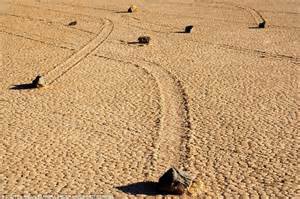
Some of the trails are peculiar in nature. Rocks will move in smooth curving paths while others will go absolutely straight suddenly shifting to the left or right at a distinct harsh angle. Trails have been measured up to 820 feet in length.
Ralph Loenzo became fascinated with the Sailing Stones and performed experimentations trying to figure out why and how they moved. After much reading and contemplation, he took a Tupperware container to show how rocks might move across the lake bed.
“I took a small rock and put it in a piece of Tupperware, and filled it with water so there was an inch of water with a bit of the rock sticking out,” Lorenz told Smithsonian.com.
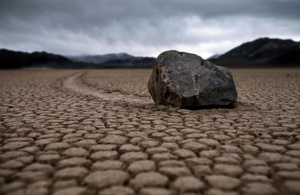 The container was put into the freezer resulting in a piece of ice with a rock embedded sticking out just a bit. He then put the ice/rock onto a tray containing sand and water. He blew on the rock which caused it to move. Lorenzo had read how ice can cause large rocks to move along in tidal beaches. Therefore, Lorenzo deduced that there was enough water below the mud which could freeze, in the winter, causing enough ice formation. With a slight breeze, these rocks would move along seemingly by themselves. People love their mysteries and oddities so many refuse this idea.
The container was put into the freezer resulting in a piece of ice with a rock embedded sticking out just a bit. He then put the ice/rock onto a tray containing sand and water. He blew on the rock which caused it to move. Lorenzo had read how ice can cause large rocks to move along in tidal beaches. Therefore, Lorenzo deduced that there was enough water below the mud which could freeze, in the winter, causing enough ice formation. With a slight breeze, these rocks would move along seemingly by themselves. People love their mysteries and oddities so many refuse this idea.
Only recently have I heard about hoodoos. A friend of mine pointed these out when we were talking about traveling through New Mexico. He has these formations on the list.
Generally, hoodoos range in size of 5 feet to 150 feet tall. Hoodoos are found scattered throughout the High Plateaus of the Colorado Plateau and the Badlands of the Northern Great Plains. However, the norther section of Bryce Canyon National Park is abundant with hoodoos.
Hoodoos are formed by erosion. Water seeping into the stone and freezing. This then acts as a wedge splitting sections of rock which through time gradually fall off. There can be up to 200 freeze/thaw cycles in one just year. Rains occur during the summer and known as monsoon rains due to their intensity. The rain actually removes much of the debris from the structures being split apart bye the freeze/thaw cycles. The rain contains carbonic acid that causing chemical reactions within the limestone. The harder rock portions between the layers of limestone are resistant to the carbonic acid. This is what cause many hoodoos to have caps and irregular shaping, as the hoodoo is deteriorating at different rates throughout. 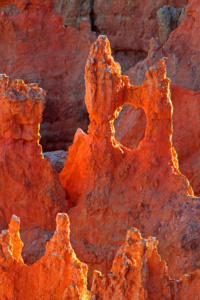 A very interesting feature of some hoodoos are the windows that are created. Erosion works in amazing way.
A very interesting feature of some hoodoos are the windows that are created. Erosion works in amazing way.
Unfortunately, the force that creates the hoodoo is just as aggressively causing its demise. Erosion occurs at two to four feet every one-hundred years. What we see today is not what was seen even 200 years ago or as will be seen 200 years in the future. That hoodoo window may be gone or a new one appears. The cap fell in shambles but a new hoodoo grows beside it. Two hundred years is actually a blink of an eye when it comes to geological eras.
Amazing and wondrous is this world we live in. The animals, rocks, plants and minerals are here to amuse and amaze. A job well done Mother Nature.
“There are no fixtures in nature. The universe is fluid and volatile. Permanence is but a word of degrees.”
― Ralph Waldo Emerson, Essays – First Series
Got out and discover what amazements are just around the corner. See the beauty that lies in wait for everyone. Be part of real life…Nature at its best.


